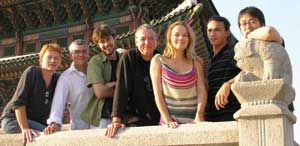Patrick Forgas was just 18 when he heard the music that would transform his life: the second Soft Machine album. The following years would see him perfect his drumming technique with several bands that were thriving in the 1970’s. He recorded a demo tape in 1975 with Didier Thibault (bass) and Dominique Godin (keyboards). However, Didier Thibault, who was formerly part of Moving Gelatine Plates, an excellent French band from the Canterbury vein that recorded two highly acclaimed albums in 1970 u0026 1971, went on to form MGP and take Godin along. Patrick would then be left on his own. The tape was noticed by Gratte-Ciel, who released Cocktail in 1977. It featured former and future members from Magma, Jean-Pierre Fouquey (keyboards), Francois Debricon (flute/sax), Patrick Tilleman and, most importantly, Gerard Prevost, the legendary bass player. Many of these musicians went on the become professional session players. Forgas started a tour band after receiving positive reviews from the press. He retained the services of Laurent Roubach, who was later known for his guitar duo album with Eric Boell. Tilleman was quickly replaced by Jorge Pinchevsky, Jean-Pierre Thirault, the saxophonist from Lard Free and Mahjun, and Eric Bono and Philippe Talet, both of whom later joined the French fusion band Abus Dangereux. The band was forced to disband after only a few gigs. They opened for Weidorje, Didier Malherbe, and Bloom, but did not record the second album. Forgas nearly quit playing music between 1978 and 1988. Forgas sold his drum set and began other non-musical jobs. He continued to write with the help of a keyboard or guitar, but it was not enough to achieve mainstream pop success. Two singles were released in the mid-eighties – with some very funny lyrics. Forgas was awarded a contract due to continued strong sales of Cocktail through Musea’s distribution network in 1988. This resulted in 1990’s “comeback album” L’Oeil. Fouquey and Roubach from Cocktail and Didier Malherbe (of Gong) were guest vocalists, synthesizers and programmers alongside Forgas. Forgas began work on Art D’Echo after receiving encouragement from musicians and magazines (including Robert Wyatt, his old inspiration). This album was inspired by the French surrealist movement and writer Andre Breton. He hired several guest talents, including his old colleagues Thirault and Debricon, as well as new acquaintances. It was recorded in Forgas’ small music room, which is so small that only two musicians can be in there at once! The sound quality was better. Forgas’s first drumming in many years was “Poltergeist”, a track that marked Forgas’s debut. It was quickly decided that a live band would be formed. The next three years were spent searching for suitable musicians and practicing a new repertoire. This new repertoire was centered around two epic compositions: “Rumeurs” later renamed “Roue Libre” and “Serum De Verite”. In March 1997, a shorter track, “Declic”, came out of the sessions. Roue Libre was published on Cosmos Music December 1997. It was promoted through a series gigs around Paris. After more personnel changes, Forgas Band Phenomena returned to the studio in January 1999 in order to record Extra-Lucide. It was released in December 1999. After a lengthy hiatus, the band returned stronger than ever in 2004. The live CD Soleil 12 was released by Cuneiform Records the next year. It included a large portion of a reworked version the two suites originally recorded for 1978’s album, “Coup De Theatre”, and a new version “Pieuvre A La Pluie”, as well as two more recent compositions, “Soleil 12” and “Eclipse”. Patrick continued to write material for a new CD between 2005 and 2006. This was after the mandatory road-testing. It was recorded in the summer 2008, right before the band went on their memorable trip to South Korea. L’Axe du Fou will be released on Cuneiform in January 2009. from http://forgasbp.online.fr
